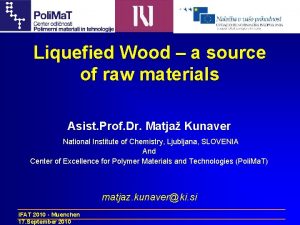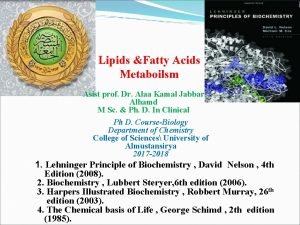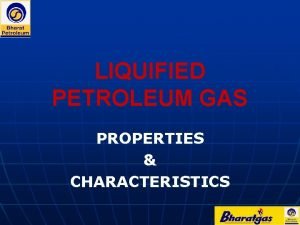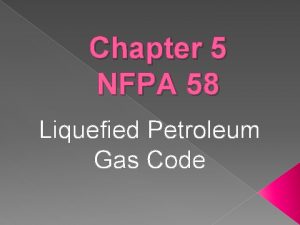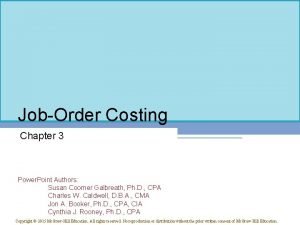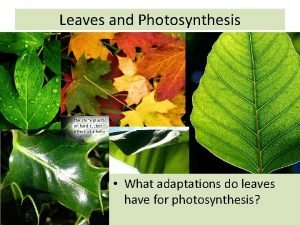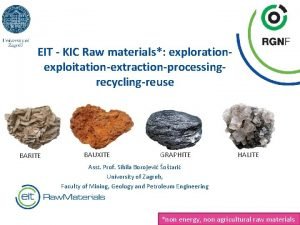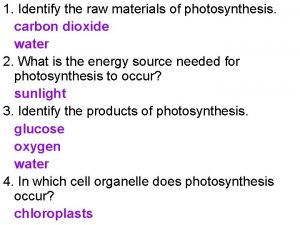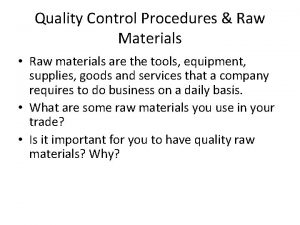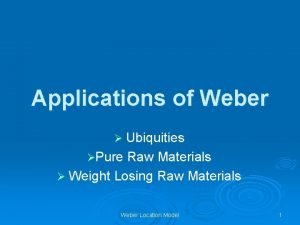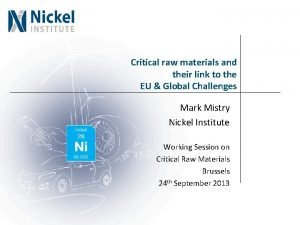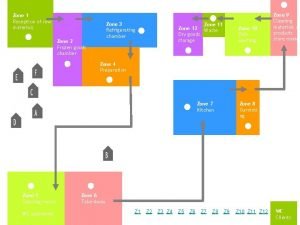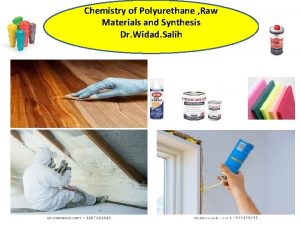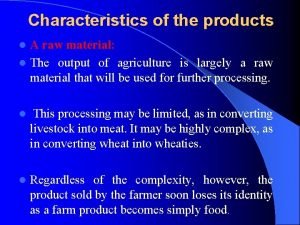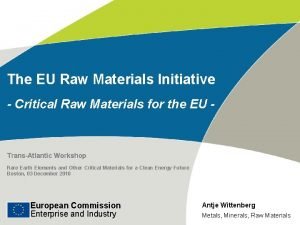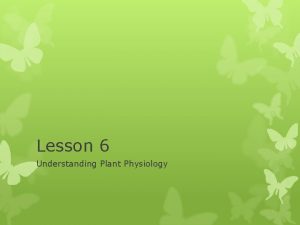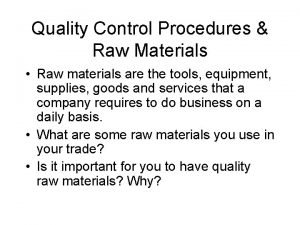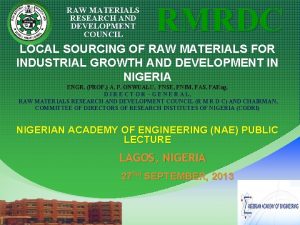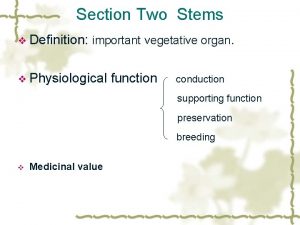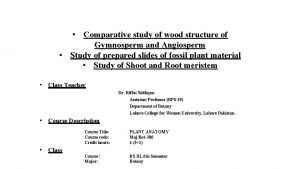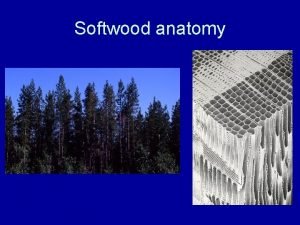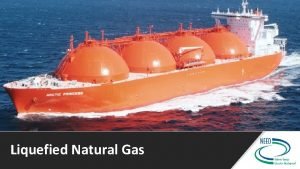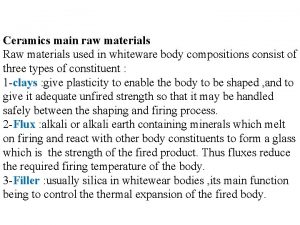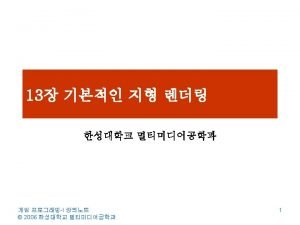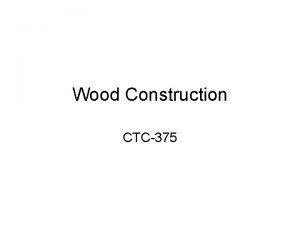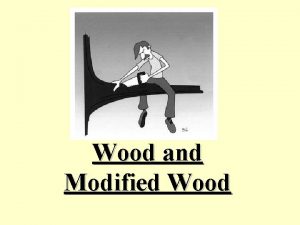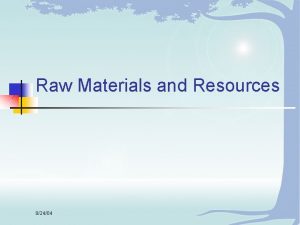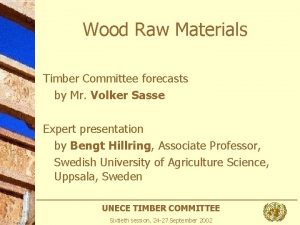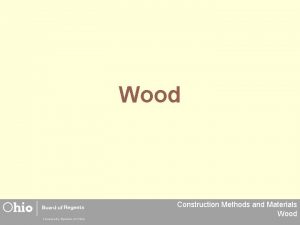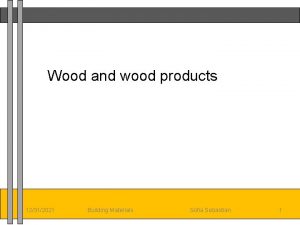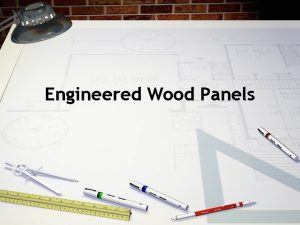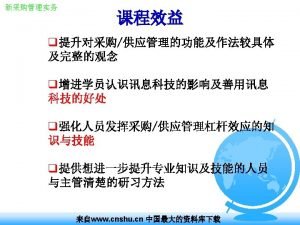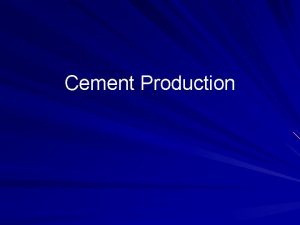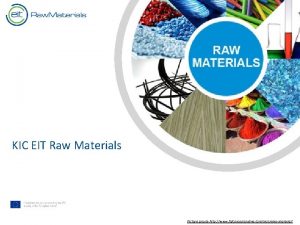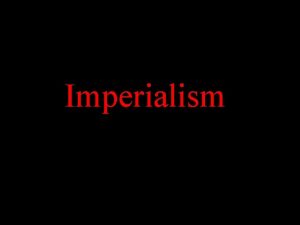Liquefied Wood a source of raw materials Asist






























- Slides: 30

Liquefied Wood – a source of raw materials Asist. Prof. Dr. Matjaž Kunaver National Institute of Chemistry, Ljubljana, SLOVENIA And Center of Excellence for Polymer Materials and Technologies (Poli. Ma. T) matjaz. kunaver@ki. si IFAT 2010 - Muenchen 17. September 2010

Geographic reasons Slovenia 58. 4% of surface is forest. Forest is spreading! IFAT 2010 - Muenchen 17. September 2010

Lignocellulosic biomass Cellulose hemicellulose Glucose Xylose, Arabinose Ethanol Fuels Organic acids, textile fibers, polymers, adhesives, lubricants, inks lignin Polymers, fuels IFAT 2010 - Muenchen 17. September 2010

Lignocellulose-based materials IFAT 2010 - Muenchen 17. September 2010

Experimental approach Unseparated wood (polymers) to undergo partial depolymerization with polyols to obtain complex multifunctional oligomeric mixture – feedstocks for polymer synthesis: Polyesters: unsaturated and saturated Polyurethanes IFAT 2010 - Muenchen 17. September 2010

What is LIQUID WOOD ? A blend of depolymerized and solubilized wood components obtained by reaction with polyhydric alcohols in the presence of acid as a catalyst. Liquefaction converts wood into a feedstock for the new, environmentally friendly polymers IFAT 2010 - Muenchen 17. September 2010

Liquefaction mechanism • Wood is a complex composite of: - highly crystalline cellulose - polyphenolic lignin - hemicelluloses - minerals, resins etc. 42 - 51% 18 – 30% 24 – 40% • Polysaccharides → glucoside→ levulinic ester IFAT 2010 - Muenchen 17. September 2010

Liquefaction mechanism • Lignin → benzyl cation → reaction intermediates → glycol ethers of depolimerized segments → condensation products IFAT 2010 - Muenchen 17. September 2010

Liquefaction process • Glass reactor with external heating, mixing - 0. 5 to 3 hours at 150 - 180 o. C • Typical reaction mixture: - 100 g wood (or lignocellulosic material) - 300 g glycol (glycerol, diethylene glycol) - 12 g acid catalyst ( p. TSA) • Product analysis: - gravimetric determination of remaining wood - FTIR, GPC analysis - OH value determination IFAT 2010 - Muenchen 17. September 2010

Liquefaction product IFAT 2010 - Muenchen 17. September 2010

Liquefaction product IFAT 2010 - Muenchen 17. September 2010

Hydroxyl content in the liquefied spruce wood samples, taken at different time intervals. OH groups are spent during the liquefaction reaction: - Formation of ester and ether bonds with glycols. IFAT 2010 - Muenchen 17. September 2010

Polyester resins from liquefied wood The main goal: to synthesize a poliester with higher molar mass than the liquefied wood and with the same functionality as the commercial one. A typical formulation: - 300 g of neutralized liquefied wood - 60 g of adipic acid - 0. 1 g of dibutyl tin oxide Temp: 190 -220 o. C , reaction time: approx. 4 hours IFAT 2010 - Muenchen 17. September 2010

SYNTHESIS OF LINEAR, SATURATED POLYESTERS FOR POLYURETHANE FOAMS Mn Dalton OH value mg. KOH/g Viscosity Pa. s 19400 1043 3. 0 24. 5 39900 798 1. 9 22. 7 60000 378 1. 8 23. 3 79500 437 2. 1 23. 1 Mw Dalton % of wood (w/w) LW 300 g LW, 60 g AA 300 g LW, 60 g PAA 300 g LW, 30 g AA, 30 g PAA 4790 10300 4590 7980 IFAT 2010 - Muenchen 17. September 2010

SYNTHESIS OF POLYURETHANE FOAMS FOAM PREPARATION: COMPONENTS: Parts by Weight Liquefied wood Catalysts 100. 0 KOC DMEA 2. 0 2. 5 Silicone surfactant 1. 5 Water, ethanol, hexane 3. 0 PMDI* 180. 0 PMDI : diphenylmethane diisocyanate polymer DMEA: N, N-Dimethyl ethanolamine KOC: potassium octoate IFAT 2010 - Muenchen 17. September 2010

SYNTHESIS OF POLYURETHANE FOAMS Polyurethane foams based on liquid wood poliols, Density = 0. 03 -0. 05 g/ cm 3 Compressive strength at 10% strain: 46 k. Pa – 74 k. Pa Thermal conductivity: 0. 036 W/m. K Addition of glycerol IFAT 2010 - Muenchen 17. September 2010

SYNTHESIS OF POLYURETHANE FOAMS Properties of polyurethane foams differ depending on the variations of the linear polyester formulation as well as final foam formulation. Pigments for coloration, additives to improve durability can easily be incorporated into the final foam formulation. Wood content: - 50% - 25 % in liquefied wood - 45% - 25% in linear polyester - 20% - 10% in polyurethane foam IFAT 2010 - Muenchen 17. September 2010

Wood content: a practical example 75 pairs of disposable chopsticks give 500 gr of wood and together with alcohols -> 1000 gr of LIQUEFIED WOOD (50% wood content). From 1000 gr of L. W. we can synthesize 1170 gr of LINEAR POLYESTER (still 43% of wood) From 1170 gr of polyester with addition of PMDI, 2930 gr of rigid POLYURETHANE FOAM can be prepared (17% of wood ) 2930 gr of PUR = 58 Lit of volume! 1 chopstick gives 0. 78 Lit of PUR foam! 1 chopstick with wrap paper gives 0. 90 Lit of PUR foam! IFAT 2010 - Muenchen 17. September 2010

PANEL BOARD PRODUCTION - OPPORTUNITIES Global Panel board production 2011: 75 Mio m 3 – Europe: 37 Mio m 3 – Asia: 32 Mio m 3 37 Mio m 3: 17 12 4 4 Mio m 3 particle board Mio m 3 MDF (Medium density fiber board) Mio m 3 Plywood boards Mio m 3 OSB (Oriented strand boards) 10% Adhesive 30% Adhesive ~15% Adhesive 17 Mio m 3 = 12 Mio Tons = 1. 2 Mio Tons of adhesive IFAT 2010 - Muenchen 17. September 2010

Liquefied wood, paper, bark – adhesives for plywood and wood chip panels Standard adhesives: Melamine –formaldehyde resins, melamine – urea – formaldehyde resins Up to 50% of adhesive can be replaced with liquefied wood. The temperature can be lowered to 160° C. Formaldehyde release: less than 5 mg/100 g European standard EN 312: 2003 compliant. IFAT 2010 - Muenchen 17. September 2010

SINGLE LAYER PARTICLE BOARD Standard adhesives: Melamine –formaldehyde, melamine – urea – formaldehyde resins Hot pressed at 180° C, 3 N/mm 2, for 5 minutes IFAT 2010 - Muenchen 17. September 2010

Liquefied wood, paper, bark – adhesives for plywood and wood chip panels Mechanical and physical properties of particle boards prepared using an adhesive that contained the addition of 50 % (w/w) liquefied spruce wood. Required values Achieved values Meldur H-97 Achieved values Meldur MS-1 16, 0 ± 0, 3 16. 1 16. 2 - 0. 68 0. 67 Above 0. 35 0. 40 0. 49 Surface soundness EN 311 (N/mm 2) Above 0. 8 1. 0 0. 9 Bending strength EN 310 (N/mm 2) Above 13 15. 9 16, 5 Swelling in Thickness EN 317 (%) Below 15 11. 6 15. 9 Below 8 5. 7 3. 6 Board thickness EN 324 (mm) Density EN 323 (g/cm 3) Internal bond strength EN 319 (N/mm 2) Formaldehyde release Perforator method EN 120 (mg/100 g board) IFAT 2010 - Muenchen 17. September 2010

THREE - LAYERS PARTICLE BOARD Standard adhesives: Melamine – formaldehyde, melamine – urea – formaldehyde resins Hot pressed at 180° C, 3 N/mm 2, for 5 minutes IFAT 2010 - Muenchen 17. September 2010

Mechanical and physical properties of particle boards prepared using an adhesive that contained the addition of 30 % (w/w) liquefied spruce wood – industrial process simulation Required values Achieved values 16, 0 ± 0, 3 16. 1 - 0. 72 Above 0. 35 0. 94 Surface soundness EN 311 (N/mm 2) Above 0. 8 1. 96 Bending strength EN 310 (N/mm 2) Above 13 21. 1 Swelling in Thickness EN 317 (%) Below 15 8. 2 Below 8 3. 2 Board thickness EN 324 (mm) Density EN 323 (g/cm 3) Internal bond strength EN 319 (N/mm 2) Formaldehyde release Perforator method EN 120 (mg/100 g board) IFAT 2010 - Muenchen 17. September 2010

Liquefied wood – polyester: adhesives for plywood panels A combination of polyester based on liquefied wood with a melamin-formaldehyde resin (1: 1 ratio). POLYESTER: 500 g L. W. 50 g APA 0. 3 g F 4201 4. 5 hours at 180 o. C-220 o. C OH value: 333. 5 mg. KOH/g IFAT 2010 - Muenchen 17. September 2010

Liquefied wood – polyester: adhesives for plywood panels A combination of polyester based on liquefied wood with a melamin-formaldehyde resin (1: 1 ratio). STANDARD EN 12765: Classification of thermosetting wood adhesives for non-structural applications. . . More than 12 N/mm 2 of the bond strength can be achieved. CLASS C 1 and C 2 compliant IFAT 2010 - Muenchen 17. September 2010

Liquefied wood – liquid fuel Liquid fuel with more than 22 MJ/kg heat of combustion (brown coal: 14 MJ/kg, dry wood: 15 MJ/kg) High viscous liquid at room temperature (3 Pa. s), but soluble in ethanol. Sulfur content: 0. 25% IFAT 2010 - Muenchen 17. September 2010

Conclusions • Different lignocellulosic materials were liquefied with yields higher than 95%, (Lignin – with additional use of the ultrasound). • Polyesters were synthesized using liquefied wood, waste paper or other lignocellulosic materials as a feedstock where liquefied wood/paper replaced a certain amount of polyhydric alcohols – produced form crude oil. • The properties of polyurethane foams were similar to commercially available samples. • Liquefied lignocellulosic materials were used as adhesives for particle boards production – with reduced formaldehyde emission and excellent mechanical properties. • Efficient lignocellulosic waste recycling and use of renewable resources, including glycerol from biodiesel production. IFAT 2010 - Muenchen 17. September 2010

Future: • Liquefaction with the use of the ULTRASOUND • Liquefied wood – MUF adhesives: new applications • Energy source and fuel • Effective wood waste recycling IFAT 2010 - Muenchen 17. September 2010

Acknowledgments: Authors wish to gratefully acknowledge the support for the presented work received from : - Ministry of Higher Education, Science and Technology of the Republic of Slovenia within Program P 2 -0145 and through the contract No. 3211 -10 -000057 (Center of Excellence Polymer Materials and Technologies). - Colleagues at the Polymer chemistry and technology laboratory - GGP for their financial and material support, - Melamin, for their general help and material support IFAT 2010 - Muenchen 17. September 2010
 Lignocellulose
Lignocellulose Asist serum
Asist serum Liquefied petroleum gas properties
Liquefied petroleum gas properties Nfpa 58 liquefied petroleum gas code
Nfpa 58 liquefied petroleum gas code Bayonet charge summary
Bayonet charge summary Costing
Costing Variegated leaf diagram
Variegated leaf diagram Kic eit raw materials
Kic eit raw materials Starting materials for cellular respiration
Starting materials for cellular respiration Material control procedure
Material control procedure Weight loss raw materials
Weight loss raw materials Raw materials examples
Raw materials examples Reception of raw materials
Reception of raw materials Types of raw materials
Types of raw materials Polyurethane raw materials
Polyurethane raw materials What raw materials does a plant need for photosynthesis
What raw materials does a plant need for photosynthesis Raw materials of sulphuric acid
Raw materials of sulphuric acid Raw material characteristics
Raw material characteristics Location planning management
Location planning management Raw materials initiative
Raw materials initiative Two raw materials necessary for photosynthesis
Two raw materials necessary for photosynthesis Quality control of raw materials
Quality control of raw materials Raw materials budget example
Raw materials budget example Rmrdc salary
Rmrdc salary Wood wood teenager
Wood wood teenager Roots method of vegetative propagation
Roots method of vegetative propagation Angiosperm wood vs gymnosperm wood
Angiosperm wood vs gymnosperm wood Esau wood poem
Esau wood poem Early wood and late wood
Early wood and late wood Man made materials
Man made materials Natural materials and man made materials
Natural materials and man made materials
